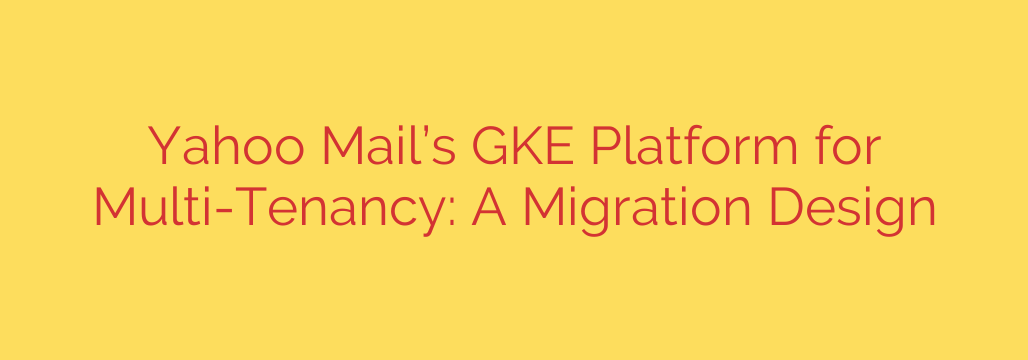
Building a Secure, Scalable Multi-Tenant Kubernetes Platform
Migrating massive, legacy applications to a modern, cloud-native environment is one of the most significant challenges in tech today. The goal is clear: leverage the power of platforms like Google Kubernetes Engine (GKE) to increase agility, reduce costs, and improve scalability. However, the path to achieving this is complex, especially when dealing with multi-tenancy—the practice of running multiple applications from different teams on the same shared infrastructure.
Successfully building a multi-tenant platform requires a meticulous approach to architecture, with security and isolation as the guiding principles. Let’s explore the core components and strategies required to design a robust GKE platform capable of handling numerous tenants safely and efficiently.
The Foundation: Moving from Monoliths to Microservices
Traditional infrastructure, often built on bare metal or virtual machines, presents several obstacles. It’s typically characterized by high operational overhead, slow provisioning times, and inefficient resource utilization. A move to Kubernetes is a move towards a more dynamic and efficient model.
The core advantage of a platform like GKE is its ability to abstract away the underlying hardware. This allows for:
- Rapid Deployment: Developers can deploy applications in minutes, not weeks.
- Automated Scaling: The platform can automatically adjust resources based on real-time demand.
- Improved Resource Utilization: Containers are lightweight and can be packed densely, leading to significant cost savings.
However, sharing this powerful infrastructure among many “tenants” (applications or teams) introduces a critical challenge: how do you ensure that tenants are isolated from one another? Without proper controls, a single misbehaving application could consume all available resources or, even worse, create a security vulnerability that affects the entire cluster.
Core Pillars of a Secure Multi-Tenant Architecture
A successful multi-tenant GKE platform is built on several key pillars that work together to enforce isolation, security, and fair resource allocation.
1. Logical Isolation with Kubernetes Namespaces
The first and most fundamental tool for multi-tenancy is the Kubernetes Namespace. A Namespace acts as a virtual boundary within a single physical cluster, allowing you to group related resources. Each tenant is assigned its own unique Namespace, which becomes their designated workspace.
This provides a basic level of separation, preventing naming conflicts and allowing for tenant-specific access controls. Think of it as creating separate, labeled rooms within a large building—while everyone is in the same building, they operate within their own defined space.
2. Enforcing Strict Network Policies
By default, all pods within a Kubernetes cluster can communicate with each other, regardless of their Namespace. This is unacceptable in a multi-tenant environment. Network Policies are the solution, acting as a firewall for your pods.
A best-practice security posture starts with a “deny-all” default policy. This means that, by default, no pod can communicate with any other pod. From there, you can create explicit “allow” rules to permit necessary traffic—for instance, allowing a front-end application to talk to its back-end database within the same Namespace. This prevents cross-tenant communication and dramatically reduces the potential attack surface.
3. Fair Resource Management with Quotas and Limits
The “noisy neighbor” problem is a classic issue in shared environments, where one tenant’s application consumes an unfair share of CPU or memory, starving other tenants. To prevent this, you must implement resource governance.
- ResourceQuotas: These are set at the Namespace level to cap the total amount of resources (like CPU, memory, and persistent storage) that a single tenant can consume. This ensures fair distribution and prevents any single tenant from monopolizing the cluster.
- LimitRanges: These policies are applied within a Namespace to set default resource requests and limits for individual containers. This ensures that every workload deployed by a tenant has sensible resource boundaries, promoting stability across the platform.
4. Secure Identity and Access with Workload Identity
Managing credentials and permissions is a major security challenge. A modern and highly secure approach on GKE is to use Workload Identity. This feature allows you to bind a Kubernetes Service Account to a Google Cloud IAM Service Account.
Instead of storing static secret keys inside your cluster—a significant security risk—Workload Identity allows pods to automatically and securely authenticate to Google Cloud services (like Cloud Storage or Pub/Sub). This eliminates the need for long-lived credentials, making the entire system more secure and easier to manage.
Key Security and Platform Design Tips
When designing your multi-tenant Kubernetes platform, keep these actionable principles in mind:
- Start with Isolation: Assign every tenant their own dedicated Namespace. This is your non-negotiable first step.
- Default to Zero Trust Networking: Implement a default “deny-all” Network Policy across your cluster. Only allow traffic that is explicitly required.
- Enforce Resource Quotas from Day One: Don’t wait for a resource contention problem to happen. Proactively set ResourceQuotas for every tenant to ensure fairness and stability.
- Adopt Modern Authentication: Move away from static secret keys. Use a solution like GKE’s Workload Identity to provide secure, temporary credentials to your applications.
- Leverage VPC-Native Clusters: This GKE feature simplifies networking by giving pods their own native IP addresses within the Virtual Private Cloud (VPC), improving performance and making network policy enforcement more straightforward.
- Automate Everything: Use a robust CI/CD pipeline to automate the onboarding of new tenants, the application of security policies, and the deployment of applications. This reduces human error and ensures consistency.
By carefully architecting a platform around these core principles of isolation, security, and resource management, organizations can successfully migrate even their most critical services to a shared Kubernetes environment. The result is a more agile, cost-effective, and secure foundation for future innovation.
Source: https://cloud.google.com/blog/products/containers-kubernetes/understanding-yahoo-mails-multi-tenant-gke-platform-design/








